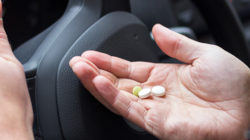
Effectiveness of Distracted Driving Countermeasures: A Review of the Literature
This research brief reviews the current scientific evidence concerning the effectiveness of existing and emerging countermeasures against distracted driving.
November 2019 Research Brief

Detection Windows for Drugs in Oral Fluid: Cannabinoids, Stimulants, and Opioids
The objective of this research brief is to assess the literature on oral fluid detection times to address how long after a person uses a drug it can be detected in oral fluid, and what factors may influence detection times.
July 2019 Research Brief

2018 Traffic Safety Culture Index
This annual Traffic Safety Culture Index (TSCI), a nationally representative survey, has been conducted to identify and assess key indicators regarding American drivers’ attitudes toward and behaviors regarding traffic safety, since 2008.
June 2019 Technical Report | Report Summary

Drug Evaluation and Classification: Review of the Program and Opportunities for Enhancement
The purpose of this project was to identify areas where potential modifications could be implemented to enhance the efficiency and effectiveness of the Drug Evaluation and Classification Program.
May 2019 Technical Report | Report Summary

Assessing the Feasibility of Evaluating the Legal Implications of Marijuana Per Se Statutes in the Criminal Justice System
This research assesses the feasibility of studying the effect of non-zero-tolerance per se limits for cannabis on the legal system.
April 2019 Technical Report | Report Summary

American Driving Survey, 2014 – 2017
The American Driving Survey collects and analyzes data related to driving patterns of the public in the United States. This brief summarized the results based on data collected from 2016 through 2017 compared to those collected from 2014 through 2015.
February 2019 Research Brief

Countermeasures Against Prescription and Over-the-Counter Drug-Impaired Driving
This report describes prescription and over-the-counter countermeasures related to pharmacy and medical; data recording and toxicology; law enforcement and judicial; and education and advertising.
October 2018 Technical Report | Report Summary

Leveraging and Enhancing Alcohol Countermeasures to Reduce Drugged Driving
Two research briefs describe a project that solicited input from subject matter experts across the U.S. regarding the potential for alcohol-impaired driving countermeasures to be adapted as drugged or drug-impaired driving countermeasures.
September 2018 // Enforcement/Legal Brief // Behavioral/Educational Brief

Properly and Effectively Adjudicating Drugged Drivers: The Development of Online Curricula
In order to expand access to training in drugged driving adjudication, the AAA Foundation funded the development and production of online courses for judges and prosecutors.
June 2018 Research Brief

Hit-and-Run Crashes: Prevalence, Contributing Factors and Countermeasures
Hit-and-run crashes and fatalities rates have been increasing at an alarming rate.
April 2018 Research Brief